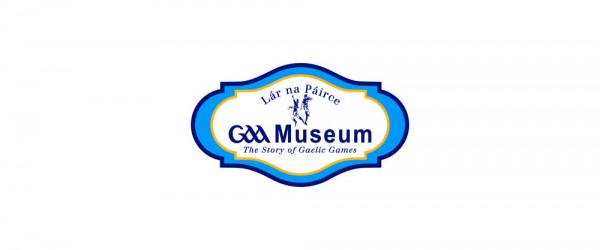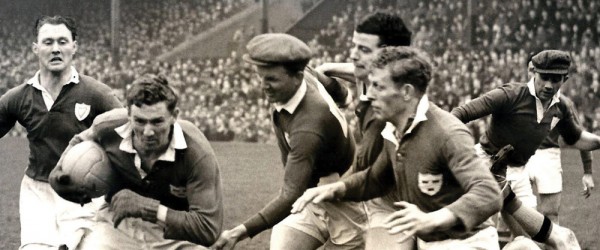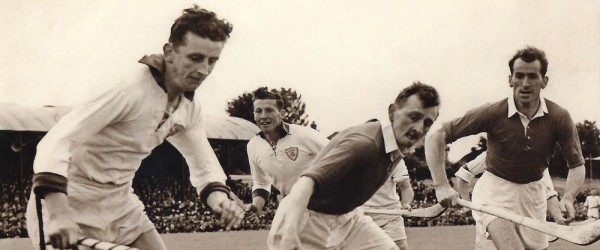
Pat Madden was captain of Galway team, defeated by Tipperary in first All-Ireland Hurling Final 1887. The hurley is on display in Lár na Páirce Museum, Thurles.
1. Pat Madden’s Hurley
Pat Madden (1860-1945) was captain of the Meelick team that represented Galway in the first All-Ireland final at Birr. It was the 1887 All-Ireland played on Easter Sunday, April Fool’s day, 1888. The team lost by 1-1 to 0-0 to Tipperary, represented by Thurles.
A tall, well built, athletic looking man, Pat was born in Meelick where hurling was traditional. An ‘ardent devotee of club games’, according to Seamus Ó Ceallaigh, who interviewed him in 1931, Pat resurrected the Meelick club in the late 1870s and gathered around him hurlers from neighbouring townslands and drew them in to the Meelick club. He was also a member of the Fenian movement and the Land League.
Following his efforts, Meelick began to make their mark in local tournaments in the early 1880s. There were some close encounters between them and Killimor, following which the teams were united with Madden as captain.
When the first championship under G.A.A. rules was organized in Galway 1887, the county was divided into two divisions, Eastern and South Western. Meelick won the former and Kilbeacanty won the latter.
The final was played at Loughrea on March 25 and the game ended in a scoreless draw. Instead of a replay the county board met that evening and awarded the championship to Meelick without assigning any winner and requested them to compete in the first All-Ireland competition. The only explanation for the board’s decision may have been political, that the IRB had enrolled the members of the Meelick club, while not yet having recruited Kilbeacanty.
Twelve counties entered the first All-Ireland, but only five participated. As a result, Meelick, having defeated Castlebridge, Wexford at Elm Park, Dublin by 2-8 to 1-0 on July 24, qualified for the All-Ireland final.
The defeat in the final was a big disappointment for Pat Madden and he probably hoped to win the 1888 championship. But none took place because of the ‘American Invasion’, when teams of hurlers and athletes travelled to the U.S. to publicise the new Gaelic Athletic Association and to secure financial help. No Galway hurler was included and this may have disappointed their captain. By 1889 the great Meelick team had disbanded.
The first All-Ireland appearance remained the high watermark of his career. About six months after the event, Pat was evicted from the family farm at Meelick, for non-payment of rent and lived a life of poverty before dying in the workhouse in Portumna on November 2, 1945. Few people marked his passing when he was buried in Meelick cemetery in a grave marked with an inscribed headstone. In 1984, the G.A.A. erected a plaque on the gable end of his homestead.
There is a connection between Pat’s eviction and the preservation of the hurley he used in the All-Ireland. The hurley was made of black sally and was probably made by Pat himself in Cullen’s house in Meelick, where most of the hurleys for the All-Ireland were made.
On the morning that Pat Madden was being evicted, he gave the hurley to the postman, Bill Tierney of Eyrecourt, who took it with him in his trap. Bill stuck it up in the thatched roof of his house and it was there until 1984 when the house was being re-roofed. Bill’s son, Willie, and his wife, Alice, always knew what the hurley meant, and would never allow it to be taken down.
In 1984, it was handed over to that great G.A.A. memorabilia collector, Sam Melbourne by Mrs. Alice Tierney and her son, Liam, for preservation. In 1988, the Sam Melbourne collection was purchased by Tipperary County G.A.A Board and formed the nucleus of the first G.A.A. museum to be set up in the country, Lár na Páirce, Thurles, which was officially opened by President Mary Robinson in 1994.
Pat Madden’s historic hurley can be seen there. It is a standard length stick with a long bas, more resembling a hockey stick that a modern hurley, as was the custom at the time. While the handle is smoothly finished off, the bas is left in a rougher state. There is a crude band of four rounds of plain wire around the bas in place of the tin band in use today.
There is no grip on the handle, which again was standard practice at the time. The grip, that is a feature of all hurleys today, was something that evolved over the years from the turn of the century onwards. Also in the museum is a Kilkenny hurley from 1904, with a barely perceptible grip, which may show a stage in that evolution to the full grip. Some authorities believe there was a stage when cord or pieces of leather were attached to the top of the handle, to ensure a firmer hold of the hurley. There is a quote from P. P. Sutton, who travelled to the U.S. with the ‘Invasion’ team in 1888, which describes the hurleys of some team as having ‘well-corded handles’.
It may come as a surprise to many that the Madden hurley was made of black sally, since ash is the predominant wood used today. However, sally could be a fitting material for hurley making in earlier times. To be found mostly in marshy ground, on ditch banks and alongside streams and river banks, in many cases it would have a natural bend, which would suit the making of a hurley. Also, it does not grow to a great size and would be ideal for the single hurley. In the case of Madden’s hurley the handle looks to have been a single growth and the bas was flattened by chopping down the sides. The sally would have other advantages. It is a soft timber and so easy to work on. It is also pliable which would suit the clash of hurleys in a match. As well, it is difficult to break, which would suit the game of hurling.
Interestingly, the oldest hurley in the National Museum collection was found in a bog in Co. Offaly. Dated circa 1500 and in surprisingly good condition, it is made of alder, a timber with many of the characteristics of sally!





